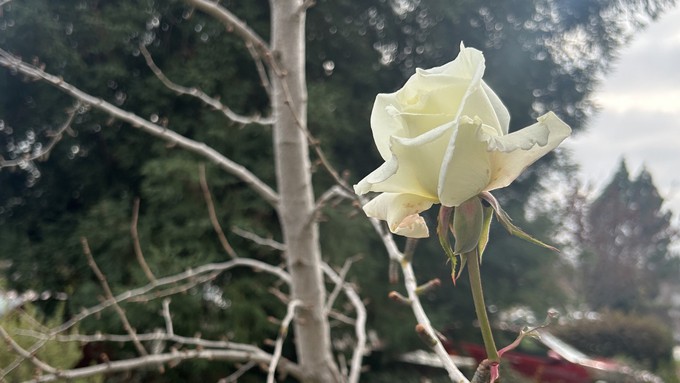
Storms take a break over Christmas weekend, but keep umbrella close

Rose growers may still have a winter rose or two, such as this Fountain Square hybrid tea rose, but it's time to start pruning the dormant plants. Kathy Morrison
It looks like Mother Nature will give us a break over this long Christmas weekend with dry weather – better for driving and for gardening (and for delivering gifts).
But more storms appear to be on the way, arriving as soon as Wednesday. According to the National Weather Service, Sacramento can expect some more wet weather, sooner than later. How much remains uncertain.
“Active weather pattern returns the middle of next week, bringing the potential for widespread rain and mountain snow,”the NWS Sacramento office posted Saturday.
Exact timing of this next round of storms is uncertain, says the weather service, noting that the weather pattern is “unsettled.” Expect a quick hit of rain Wednesday and Thursday, followed by more stormy weather right into the New Year.
There’s still a lot of moisture in the ground, and that contributes to patchy fog every morning before the rain arrives. Overnight lows are staying relatively warm, dipping to about 40 degrees. Once the fog clears, daytime highs will edge close to 60 degrees.
Make the most of time between storms – and work off some of those holiday calories. Get outside and get to work.
* Prune, prune, prune. Now is the time to cut back most deciduous trees and shrubs. The exceptions are spring-flowering shrubs such as lilacs.
* Now is the time to prune fruit trees. Clean up leaves and debris around the trees to prevent the spread of disease.
* Prune roses, even if they’re still trying to bloom. Strip off any remaining leaves, so the bush will be able to put out new growth in early spring.
* Clean up leaves and debris around your newly pruned roses and shrubs. Put down fresh mulch or bark to keep roots cozy.
* When it’s too wet to get outside, browse through seed catalogs and start making plans for spring and summer.
* Plant bare-root roses, trees and shrubs. If your ground seems saturated, consider planting your garden additions in large black plastic pots. The black plastic will warm up faster than the ground soil and give roots a healthy start. Then transplant the new addition (rootball and all) into the ground in April as the weather warms.
* Transplant pansies, violas, calendulas, English daisies, snapdragons and fairy primroses.
* In the vegetable garden, plant fava beans, head lettuce, mustard, onion sets, radicchio and radishes.
* Plant bare-root asparagus and root divisions of rhubarb (but not in soggy soil).
* In the bulb department, plant callas, anemones, ranunculus and gladiolus for bloom from late spring into summer.
Comments
0 comments have been posted.Sacramento Digs Gardening to your inbox.
Sites We Like
Garden Checklist for week of July 21
Your garden needs you!
* Keep your vegetable garden watered, mulched and weeded. Water before 8 a.m. to reduce the chance of fungal infection and to conserve moisture.
* Feed vegetable plants bone meal, rock phosphate or other fertilizers high in phosphate to stimulate more blooms and fruiting. (But wait until daily high temperatures drop out of the 100s.)
* Don’t let tomatoes wilt or dry out completely. Give tomatoes a deep watering two to three times a week.
* Harvest vegetables promptly to encourage plants to produce more. Squash especially tends to grow rapidly in hot weather. Keep an eye on zucchini.
* Pinch back chrysanthemums for bushy plants and more flowers in September.
* Remove spent flowers from roses, daylilies and other bloomers as they finish flowering.
* Pinch off blooms from basil so the plant will grow more leaves.
* Cut back lavender after flowering to promote a second bloom.
* It's not too late to add a splash of color. Plant petunias, snapdragons, zinnias and marigolds.
* From seed, plant corn, pumpkins, radishes, winter squash and sunflowers.